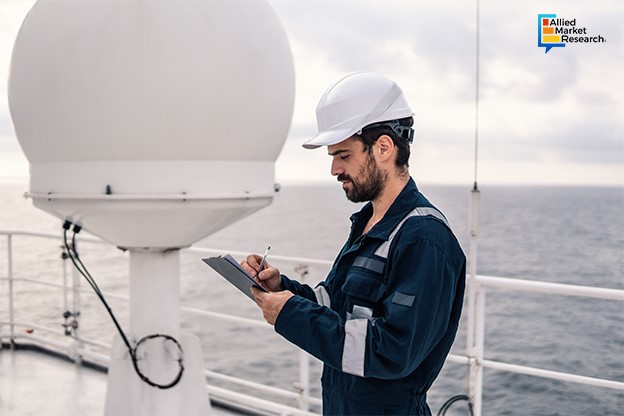Maritime VSAT Technology: Ensuring Reliable Communication for Modern Vessels

12 Jul
2024
Highlights:
- Introduction
- Promising use cases of maritime VSAT technology
- Key acquisitions of leading players in the landscape
In today's interconnected world, reliable communication is highly essential for every industry, including maritime operations. Maritime functionalities include commercial shipping, fishing, oil and gas exploration, and luxury yachting, which need robust and safe connections. The evolution of maritime VSAT (Very Small Aperture Terminal) has redefined satellite communications. This technology has revolutionized maritime connectivity by offering high-speed, reliable, and cost-effective communication solutions essential for operational efficiency and crew welfare.
The Evolution of Maritime Communication
Before the advent of VSAT, maritime communication relied heavily on technologies like Inmarsat, HF (High Frequency) radio, and Iridium satellite phones. While these systems provided basic connectivity, they were often limited in bandwidth, coverage, and reliability. With the growing demand for high-speed internet and real-time data transfer, these traditional systems began to fall short.
Maritime VSAT emerged as a solution to these limitations, offering significantly higher bandwidth and more reliable connections. The development of VSAT technology coincided with advances in satellite technology, including the deployment of HTS (high-throughput satellites) that provide greater capacity and coverage. This synergy has allowed maritime VSAT to become the preferred choice for many maritime operators.
Diverse functionalities of maritime VSAT
Maritime VSAT technology has been continually evolving, driven by advances in satellite communications and the increasing demand for reliable and high-speed connectivity at sea. Such advancements extend the applications of maritime VSAT beyond basic communication, encompassing a range of sophisticated and data-driven functionalities. In recent years, the maritime industry has embraced IoT technology significantly. VSAT enables the seamless connectivity required for IoT devices to operate efficiently. These devices monitor various aspects of a vessel's operation in real-time, such as engine performance, fuel consumption, cargo conditions, and environmental parameters. Data from these sensors is transmitted via VSAT to shore-based operations centers for analysis, facilitating predictive maintenance, operational optimization, and compliance with environmental regulations.
Moreover, crew welfare is an emerging concern in the maritime industry, and VSAT plays a key role in enhancing seafarers' quality of life. With reliable internet access, crew members stay connected with their families, access entertainment, and continue their education through e-learning platforms. Advanced VSAT applications also support AR and VR-based training programs, allowing crew members to engage in immersive training sessions that can enhance their skills and safety awareness.
In addition, accurate navigation and weather information are essential for safe and efficient maritime operations, especially for commercial ships and unmanned marine vehicles. Maritime VSAT allows these vessels to receive real-time updates on weather conditions, sea states, and navigational hazards. This information helps with route optimization, avoiding dangerous conditions, and improving fuel efficiency. Integration with advanced navigation systems also supports dynamic route planning and enhances situational awareness.
Viasat and SES's transformative moves revolutionizing satellite networks
In May 2023, Viasat Inc., a global communications company announced its acquisition of Inmarsat, a British satellite telecommunications company, offering mobile satellite communication services and delivering reliable, seamless global connectivity. With this acquisition, the companies aimed to increase the pace and scope of innovation in the global satellite connectivity sector, offering new and improved capabilities to customers, addressing their demand for ever-increasing speed, flexibility, reliability, coverage and security. In a conference, Mark Dankberg, Chairman and CEO of Viasat, said that with this partnership, the companies visioned to bring people, technology, innovation, network assets, and spectrum resources together to offer customers a multi-layered network that give them the right connectivity at the right time, place and price.
Similarly, in April 2024, SES, the EU-based satellite corporation acquired American competitor Intelsat, the market leader in maritime VSAT for $3.1 billion. This acquisition helped SES to expand its multi-orbit space network, spectrum portfolio, ground infrastructure around the world by enhancing its go-to-market capabilities, managed service solutions, and financial profile. For Intelsat, the acquisition is a vindication of a long-term turnaround strategy. The firm emerged with new owners and new top executives, who reversed its fortunes over the past two years.
The future of maritime VSAT
The future of the maritime VSAT industry is expected to be promising, with continuous advancements in satellite technology. The advent of LEO satellite constellations, such as SpaceX's Starlink and OneWeb, is set to revolutionize the industry by providing low-latency, high-speed internet access. These constellations consist of hundreds to thousands of small satellites orbiting closer to the Earth, significantly reducing latency and improving coverage, especially in remote and polar regions.
Winding up, maritime VSAT has transformed the way vessels communicate and operate, providing matchless speed and robust network that is essential for modern maritime operations. Further, the growing implementation of big data and analytics in the maritime industry is expected to ensure better connectivity and enhanced operational efficiency of vessels in a rapidly expanding digital world.
To identify and capitalize on new market opportunities in the maritime VSAT industry, feel free to contact our esteemed analysts today! They will also help you identify and mitigate risks associated with investments.

Rosy Behera
Author's Bio- Rosy Behera holds a bachelor’s degree in Electrical and Electronics Engineering and now she is a content writer by profession. She loves to portray her thoughts and ideas with a nice command of words. Grabbing an audience with her creative write-ups is one of her biggest assets so far. Apart from writing, she is a certified “Odisi” dancer and has done Gardharva in Drawing, Painting, and Arts. She always explores new things through travel and is a big foodie.
How Are Defense Manufacturers Responding to the Changing Scenario in the Armored Vehicle Industry?
Avenue: Entire Library membership of Allied Market Research Reports at your disposal
- Avenue is an innovative subscription-based online report database.
- Avail an online access to the entire library of syndicated reports on more than 2,000 niche industries and company profiles on more than 12,000 firms across 11 domains.
- A cost-effective model tailored for entrepreneurs, investors, and students & researchers at universities.
- Request customizations, suggest new reports, and avail analyst support as per your requirements.
- Get an access to the library of reports at any time from any device and anywhere.
Related Post
-
How are Submarine Cables Transforming Global Connectivity with Enhanced User Experience?
-
Endoscopy Procedures: Transformations in Techniques and Applications
-
AI-Powered Video Analytics: How the Product Actually Works for enterprises
-
Painting Robots: Transforming Precision Coating and Creative Applications
-
Innovations in Pharmacovigilance Systems Advancing Patient Safety
-
Understanding Edge Security: Keeping Data Safe Near the Source
-
Exploring the Use and Advancements of 3D Laser Scanners in Professional Applications
-
Reinforcing Industrial Controls with Smarter Tools and Training








